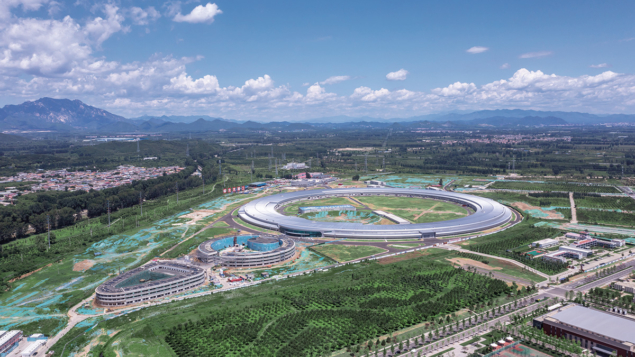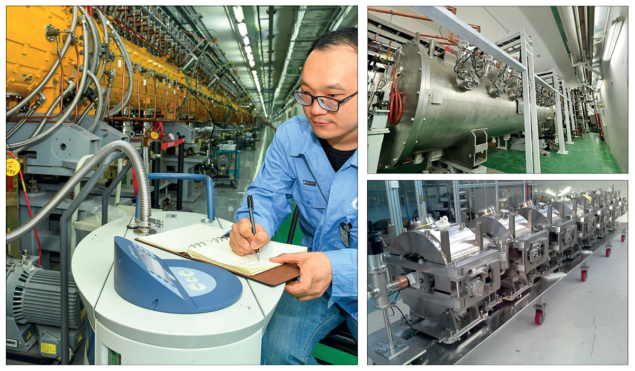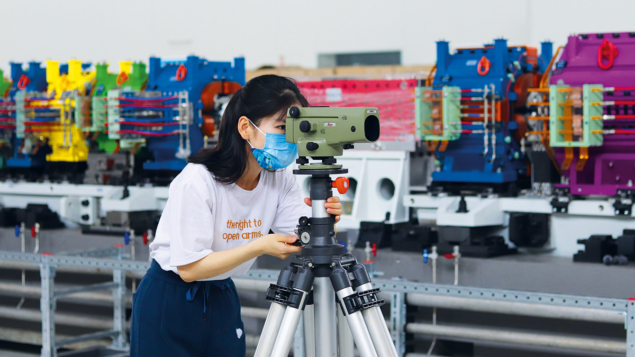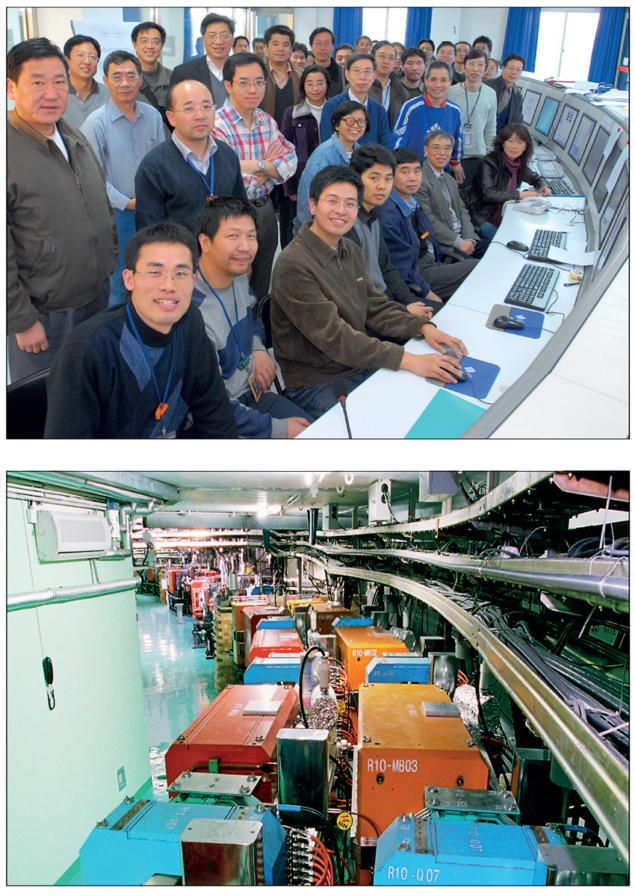China’s Institute of High Energy Physics (IHEP) is seeing strategic and operational benefits from its long-term investment to establish – at scale – an internationally recognised centre-of-excellence for accelerator research and technology development. Yifang Wang and Yuhui Li provide the inside story plus a status update on design studies for the proposed Circular Electron–Positron Collider (CEPC).

The Institute of High Energy Physics (IHEP), part of the Chinese Academy of Sciences, is in the vanguard of China’s expansive – and rapidly growing – scientific endeavours in elementary particle physics. One of the engine-rooms of that research effort is the IHEP accelerator division, the largest accelerator R&D programme in China, which has a similarly expansive remit covering the planning, design, construction and delivery of large-scale accelerator projects – on time and within budget – as well as the training and development of the next generation of accelerator scientists and engineers.
The origin story of the IHEP accelerator division can be traced back more than half a century. In 1964, Jialin Xie, the pioneer of Chinese accelerator science and technology, built the country’s first linear accelerator (a 30 MeV electron linac), laying the ground for the development of future large-scale accelerator facilities in China.
Fast forward to the 1980s and IHEP’s construction of the Beijing Electron–Positron Collider (BEPC) – the foundation of the institute’s own accelerator science programme. Since then, a talented and multidisciplinary accelerator team has grown and developed alongside IHEP’s ambitious research programme in high-energy physics. Today, the IHEP accelerator team is made up of around 370 scientists and engineers, 110 postgraduate students, 26 postdocs and numerous guest scientists working across IHEP’s two campuses in Beijing and Dongguan (an industrial city close to Hong Kong).
Project management: it’s all about delivery
The IHEP accelerator team works on advanced electron and proton accelerators, with deep domain knowledge and capabilities spanning a broad base of enabling technologies, including (but not limited to) precision mechanics; magnets and power supplies; ultrahigh vacuum components and nonevaporable-getter-(NEG)-coated vacuum chambers; cryogenic systems; superconducting magnets and RF cavities; RF power equipment and accelerating structures; as well as autocontrol systems and cutting-edge instrumentation for beam diagnostics and steering.

Furthermore, that collective IHEP know-how – tying together fundamental accelerator science, technology innovation and systems engineering – has scaled dramatically over the past 20 years as the team has overseen the construction and enhancement of several large-scale accelerator initiatives, including: the upgrade of the Beijing Electron–Positron Collider (BEPCII); a high-current proton injector for the Accelerator Driven Sub-critical System (ADS); the China Spallation Neutron Source (CSNS); the High Energy Photon Source (HEPS); as well as formative design work on the proposed 100 km Circular Electron–Positron Collider (CEPC). This is big science at scale – a diverse programme of accelerator R&D that required all manner of technology/engineering innovation along the way:
1. BEPCII (2004–2009)
BEPCII was a five-year effort to upgrade the original BEPC with a new injector as well as replacing its single-ring collider with a double-ring architecture. Upon completion of the upgrade, BEPCII entered operation in 2009 with an adjustable beam energy in the range 1.0–2.3 GeV and a beam current of 910 mA. Significant progress was registered in terms of the core enabling technologies for a high-beam-current, high-luminosity electron–positron collider, as well as in the design optimisation, system integration and project management. The luminosity of BEPCII reached the design goal of 1 × 1033 cm–2.s–1 at a beam energy of 1.89 GeV (100 times higher than that of BEPC). These successful outcomes informed and shaped subsequent IHEP accelerator projects, including the proposal for the future 100 km CEPC (see below).
2. ADS (2010–2017)
ADS is a high-power, high-intensity proton machine that has potential applications in nuclear-waste transmutation as well as thorium-based energy production. Under the auspices of the Chinese Academy of Sciences, IHEP developed the world’s first high-frequency, high-power and continuous-wave (CW) proton injector for ADS – the building blocks consisting of a CW radiofrequency quadrupole (RFQ), a superconducting linac, a beam dump and transport lines. The RFQ operates in 325 MHz CW mode, providing a 3.2 MeV acceleration capability, while the superconducting spoke cavities installed in the 2 K cryomodules have successfully accelerated the 10.6 mA proton beam to an energy of 10.67 MeV. As such, ADS is the first proton linac operating at such a high beam current (and integrated by 14 superconducting spoke cavities with a record-breaking beta value of 0.12).
3. CSNS (2011–2018)
The CSNS is located on IHEP’s Dongguan campus and consists of an accelerator, a target station and several neutron instruments. The accelerator complex itself is made up of an H– ion source (with 20 mA current), a four-vane RFQ linac (at 3 MeV), four drift-tube linac tanks (80 MeV), a rapid circling synchrotron (1.6 GeV/25 Hz) and various beam transfer lines.
CSNS construction was completed in 2018, with the beam power reaching the design value of 100 kW in February 2020. The uncontrolled beam loss rate is less than 1 W/m thanks to IHEP’s custom-designed collimation system and successful mitigation of space-charge effects. Beam availability during 2021/22 operations reached 97.1% (with 5262 hours of effective beam-time on-target).
The CSNS-II upgrade has since been approved, with construction scheduled to start in 2023. CSNS-II is designed to have a beam power of 500 kW – a capability that will be achieved by adding 20 superconducting double-spoke cavities and 24 six-cell ellipsoidal superconducting cavities to increase the linac beam energy to 300 MeV. Peak current intensity will, in turn, be scaled from 15 mA to 50 mA.
4. HEPS (2019–2025)
HEPS is a fourth-generation synchrotron radiation facility under construction in Huairou, a district in northern Beijing. HEPS consists of a 6 GeV storage ring with a circumference of about 1.3 km, a full energy booster, a 500 MeV linac, three transfer lines, multi-beamlines and corresponding experimental stations. In terms of performance, HEPS aims to have a beam current of 200 mA and a record-breaking ultralow emittance (better than 0.06 nm-rad), promising spectral brightness up to 1 × 1022 phs∙s-1∙mm-2∙mrad-2∙(0.1% BW)-1 in the typical hard X-ray regime.
The storage ring consists of 48 hybrid seven-bend acrhomats, with alternating high- and low-beta straight sections to accommodate various types of insertion devices. An innovative and high-energy, accumulation-aided on-axis swap-out scheme is adopted for injection from the booster to the storage ring. In addition, the ultralow-emittance design imposes very-high-precision requirements on all equipment as well as beam diagnostics and controls (with temperature fluctuation in the tunnel also kept within 0.1 °C).
Worth adding that HEPS will function as a “green accelerator”, with a 10 MW solar power generator (the largest solar power station in Beijing) on the roof of the storage ring serving as a test-case for future machines.
The HEPS ground-breaking ceremony took place in 2019, with the linac and booster installation now nearing completion. Installation of the storage ring will be completed in 2023, with the first synchrotron X-rays expected in 2024.
The CEPC blueprint: theory meets technology
A legacy of successful project delivery and technology innovation on these accelerator initiatives means IHEP physicists are looking ahead to a bright future. Soon after the discovery of the Higgs boson at CERN a decade ago, IHEP scientists unveiled a grand plan to build the CEPC – which will function as a “Higgs factory” – followed by construction of a Super Proton–Proton Collider (SppC) to be housed in the same tunnel. The scope and ambition of these combined facilities would, were they to be realised, unquestionably position IHEP at the cutting-edge of particle physics and accelerator science for decades to come.

At the same time, fleshing out the design, technology and engineering requirements for a next-generation accelerator complex like the CEPC is, by necessity, a collective endeavour, involving a network of collaborations with scientists and engineers at large-scale research facilities around the world. In terms of high-level design specifications, the circumference of the collider is optimised to be 100 km (based on the construction cost, operational performance and upgrade considerations for the SppC). Meanwhile, the lattice of the CEPC collider ring, as well as the interaction region, are specified so as to achieve high luminosities switchable among various energies corresponding to the Z, W and the Higgs bosons. A number of thorny challenges have already been overcome during the design phase, including beam–beam effects, strong collective instabilities, and radiation background and dose shielding.
As with all big science initiatives, innovation and cost reduction are ever-present priorities. With this in mind, a number of new technologies are under study – for example, an electron-beam-driven plasma acceleration scheme for the linac injector, as well as the iron-based superconducting coils for the SppC. IHEP is also devoting its efforts to designing the CEPC as a dual-use machine – i.e. a Higgs factory on the one hand, as well as a high-flux, high-energy gamma-ray (up to 100 MeV) synchrotron light source with a multidisciplinary research programme of its own.
CEPC is, by necessity, a collective endeavour, involving a network of collaborations with scientists and engineers at large-scale research facilities around the world
Over the past decade, IHEP and its collaborators have been working on an extensive programme of technology R&D projects as part of the validation and iteration for the CEPC and SppC design studies. Significant progress can be seen along a number of coordinates, including: electropolishing and mid-temperature processing to yield state-of-the-art performance in the 1.3 GHz nine-cell and 650 MHz single-cell superconducting RF cavities; all design specifications met in prototypes of unprecedented low-field dipole and dual-aperture magnets; and prototype energy-efficient klystrons demonstrated an efficiency of 70.5% (closing in on the ultimate target value of 80%). Equally important in this regard is the fact that around 40% of the CEPC hardware requirement will exploit existing platform technologies that are already established at facilities like HEPS, CSNS and BEPCII.
Collaborate and accelerate
One thing is clear: cross-disciplinary and cross-border collaboration are going to be key to translating the technical vision underpinning the CEPC (and the SppC) into scientific reality. In this regard, IHEP is well placed, having a successful track-record of domestic collaboration with accelerator facilities across the country. IHEP scientists and engineers, for example, helped to build the Shanghai Light Source, and collaborated with the Institute of Modern Physics in Lanzhou to build ADS. Cooperation is underway now with the Shanghai Free Electron Laser Facility (to develop and produce superconducting RF cavities) as well as the Dalian Light Source (to build a complete superconducting accelerator module, including cavities and other components).

It goes without saying that international collaboration is also hard-wired into IHEP’s operational model, with long-term R&D partnerships established in the US (e.g. Brookhaven National Laboratory and SLAC), Europe (CERN and DESY) and Japan (KEK) – and with many of these partners very much to the fore during the construction of BEPC/BEPCII, CSNS, ADS and HEPS. It works both ways, of course, with IHEP recently contributing to CERN’s High Luminosity-LHC upgrade with the provision of 13 units of superconducting corrector magnets.
As for the future CEPC, the technology R&D effort is being led by IHEP with extensive support from domestic research institutes – including Peking University, Tsinghua University and Shanghai Jiao Tong University – and with additional inputs provided by an Institution Board of 32 universities and research centres. Meanwhile, the CEPC international network comprises an International Advisory Committee (IAC), International Accelerator Review Committee (IARC) and the International Detector R&D Review Committee (IDRDC). The global nature of the collaboration is evident in the CEPC Conceptual Design Report – which has some 1143 authors from 221 research institutes (including 144 overseas institutions across 24 countries) – while the CEPC study group has also signed more than 20 memoranda of understanding with research facilities and universities around the world.
Wide-scale engagement is everything just now. As such, the CEPC accelerator team has been a participant in the commissioning of KEK’s SuperKEKB electron–positron
collider in Tsukuba, Japan, and has worked with the Future Circular Collider (FCC) team at CERN on fundamental studies of beam–beam interactions and related aspects of beam physics. There’s also been extensive outreach to industry via the CEPC Industry Promotion Consortium (CIPC). Established in 2017, the CIPC now has more than 70 industrial companies participating within China.
For IHEP’s accelerator division, and its domestic and international partners, a new world of scientific opportunity is rapidly taking shape.







